Nothing fancy in Forgotten New York for this week’s feature. Just a presentation of some photos of Manhattan and Bronx’ classic navy blue and white street signs, first installed in the early 1910s and in use by the Department of Traffic well into the 1960s. (The last one in official use, attached to a telephone pole, was on the obscure corner of De Lavall Avenue and Allen Place, a street that didn’t turn up on most official gazeteers, way up in Eastchester, a Bronx neighborhood close to the county of Westchester.}
My friend Steven Gambara, who has already published a history of NYC stoplights, has embarked on a history of NYC street signs, which will no doubt include some of the designs shown on this page. Admittedly, my knowledge of NYC street signs’ history is sketchy. I can only report to you what I’ve seen firsthand, and cannot tell you anything about the manufacturers or even the handsome serifed font used on the signs. Perhaps, Gambara’s upcoming research will shine a light on these topics.
What I know: streets were marked in a catch-as-catch can fashion for decades. Street names were chiseled onto brickface or concrete at street corners; mounted on small wooden signs on telephone poles; installed on the glass tops of gas lamps and early electric post-top lampposts; or in small, enamel or porcelain navy blue and white signs mounted on buildings.
In the mid-1910s, NYC embarked on a more concerted effort to standardize street signs. By that time, large electric-powered streetlamps, either in Bishop Crook and longarmed “Corvington” varieties, had already appeared in numbers along Manhattan and Bronx streets. Until 1914, Manhattan and the Bronx were united in New York County; after that year, the Bronx was a county on its own, and Manhattan and New York County became coterminous. On the corners with large lampposts, blue and white streets indicating the street, with the cross street indicated in an oval extension of the sign at the top (hence the term “humpback”) were installed catercorner to each other, one pair of signs to each corner. Special decorative brackets were designed to attach them to the lamppost and hold them in place; in outlying areas of the Bronx, these brackets would also appear on telephone poles.
As stated, Manhattan and Bronx designs were identical, since they were originally the same county. “Humpbacked” signs also appeared in Brooklyn from the mid to late century. The lettering was plainer and not as handsome as the Manhattan-Bronx signs. Queens and Staten Island had various types of street signs, for a couple of decades, both boroughs settled on two small signs per corner arranged in a cross, perpendicular to each other. (Queens’ signs were unusually informative, showing the modern name of the street and the former name in smaller type at the bottom.
Most of the images on this page are lifted from EBay postings, where many of the the signs are going for $300 or better.
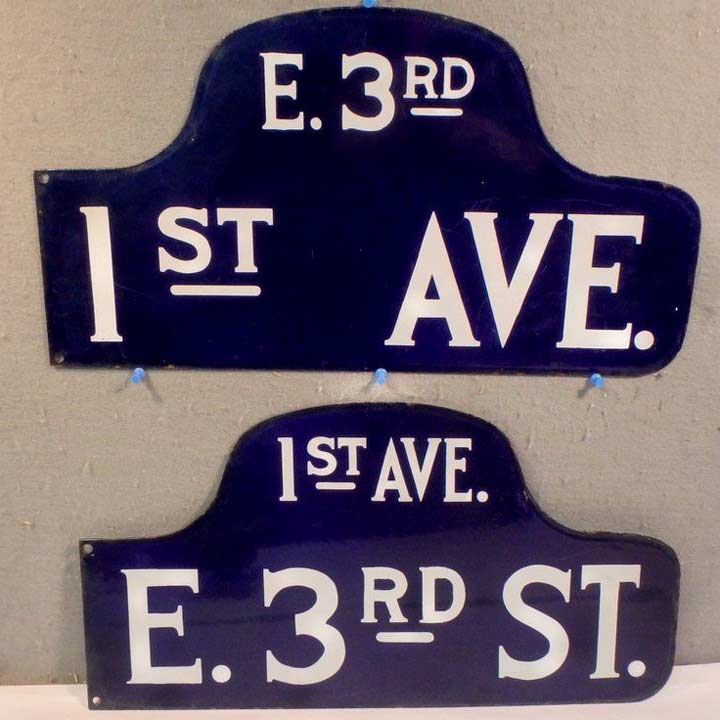
From a corner in the East Village. The serifed font used on these signs is completely unique and can’t be found in any of the type books I kept from my Photo-Lettering days, when I worked for the city’s biggest type supplier.
There’s a fascinating video shot in about 1930 or 1931 in youtube called Broadway By Day, filmed along the route from Yonkers south to the Battery. You can see a lot of these style signs therein. Once you start watching it, you have to finish it — so watch it after you finish reading this page!
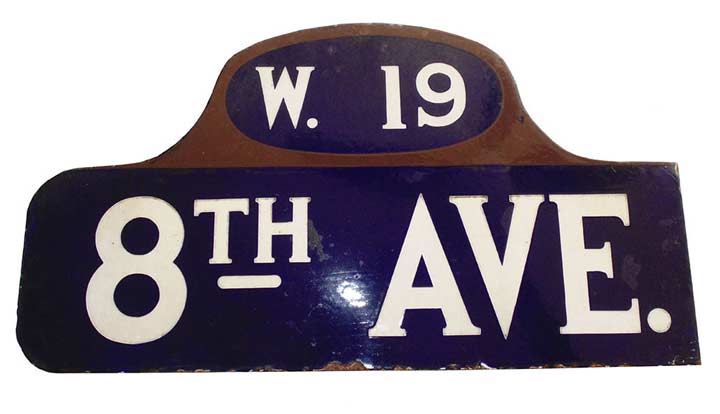
From Chelsea. A portion of the bracket is still attached.
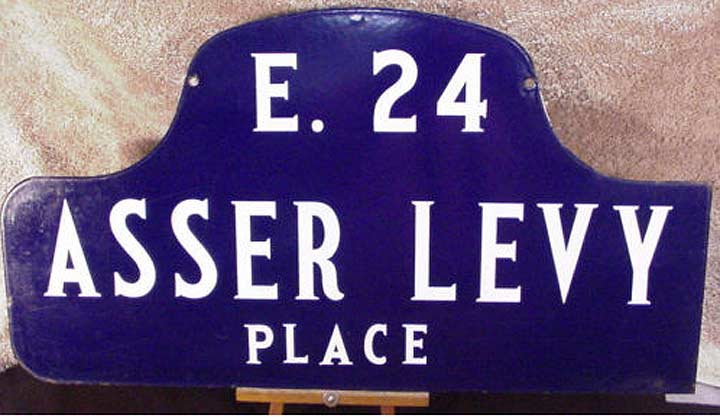
According to FNY Correspondent Sergey Kadinsky:
Prior to the construction of Stuyvesant Town and Peter Cooper Village in the 1947, Avenue A ran north from Houston Street to E. 24th Street, where a bend in the East River interrupted the grid. With the construction of the middle-class apartment complex, Avenue A terminated at E. 14th Street and the two-block remnant north of E. 23rd Street was renamed in 1954 for Asser Levy, an early leader in New York’s Jewish community when it was still New Amsterdam.
Therefore, if Avenue A was renamed Asser Levy Place in 1954, the ‘humpbacks’ were still in production at that relatively late date.
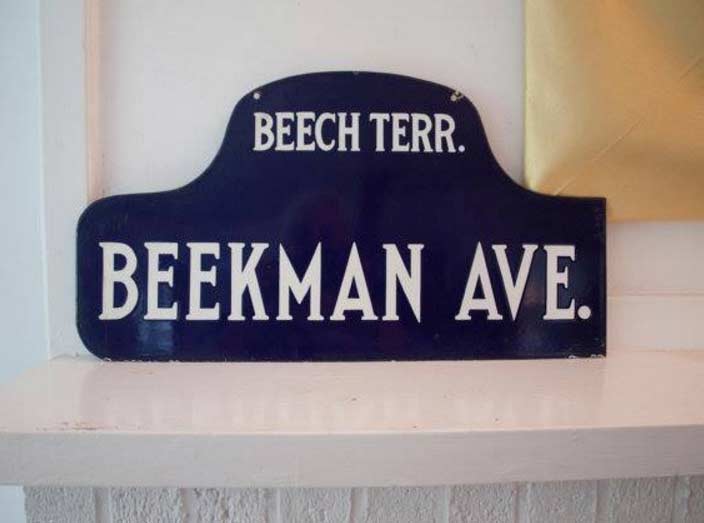
“Beekman” is a common name on NYC street signs. There’s a Beekman Street in the South Street Seaport area, commemorating the 17th Century landholdings of Willem Beeckman, who arrived in New Netherland with Peter Stuyvesant. North of the U.N., there’s a Beekman Place, which commemorates the former location of the mansion Mount Pleasant” built by a Beekman family scion, James Beekman.
This sign, however, comes from the Mott Haven section of the Bronx where it commemorates Henry R. Beekman, commissioner of the Parks Department in 1886, the year when nearby St. Mary’s Park was founded. In the mid-1850s, according to the late Bronx historian John McNamara, that general area was called “Actorville” because a number of thespians made their homes there.
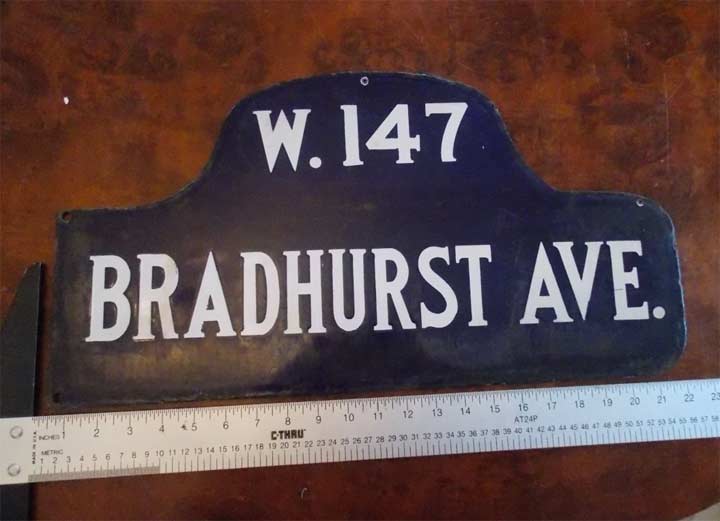
Note the ruler next to the sign indicating that each was 22 inches across. If a street had a lengthy name, the type was condensed to fit. Remember, this was done by an artist’s or a typographer’s hand in the days before computers or even phototype could be used to condense type fonts.
The sign was originally placed in northern Harlem. Samuel Bradhurst was a colonial-era druggist who purchased an uptown estate near the Hamilton Grange.
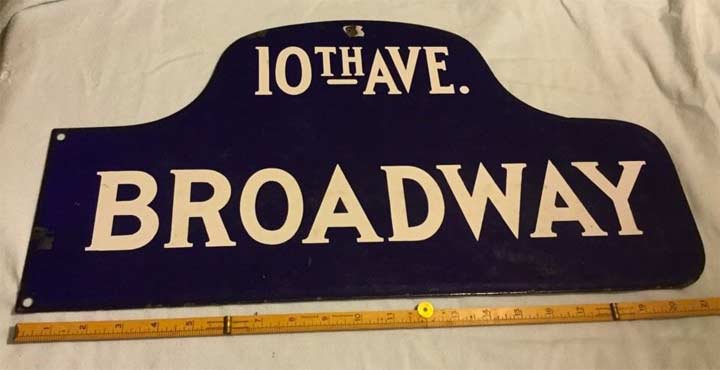
Broadway actually intersects with 10th Avenue twice — or used to. Before 1890, Amsterdam Avenue was called 10th avenue, while Broadway intersects it at West 72nd Street, though it’s likely that Broadway was known as The Boulevard at the time: the entire road wasn’t called Broadway until 1898.
10th Avenue resumes far uptown in Inwood, intersecting Broadway and transferring the #1 elevated train at West 216th Street.
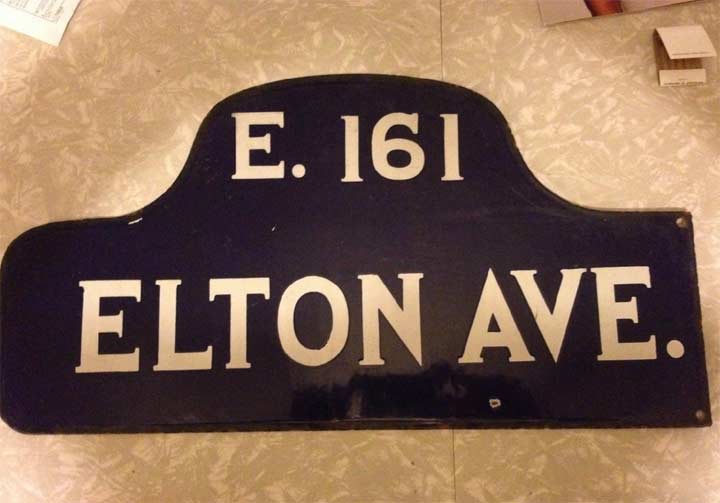
Elton Avenue runs for a few blocks in the Melrose section of the Bronx, beginning and ending at Third Avenue at East 152nd and at East 162nd.

You have to follow an Elton sign with a John sign. The street runs from Broadway east to South Street — the easternmost block is also known as Burling Slip, a former dockway. The sign commemorates shoemaker John Harpendingh (or Harperding or Haberdinck — documents were handwritten in the colonial era. We can be glad that his first name stuck instead of his last name).
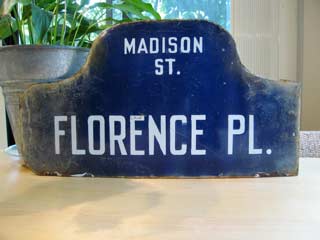 This sign seems to be an outlier among the ‘humpbacks’ as the traditional serif font wasn’t used here. Florence Place no longer exists —
This sign seems to be an outlier among the ‘humpbacks’ as the traditional serif font wasn’t used here. Florence Place no longer exists —
A street along the west side of the Manhattan Bridge approach, from Bayard Street at the line of Forsyth Street to East Broadway at Market Street. Initially called New Market Street, it was named Florence Place in 1913. The part between Bayard and Division Streets was eliminated about 1960 for the Confucius Towers site. The part between Division Street and East Broadway was then added to Market Street.
That’s not the final word, though, and I showed some other possibilities for its location on this FNY page.
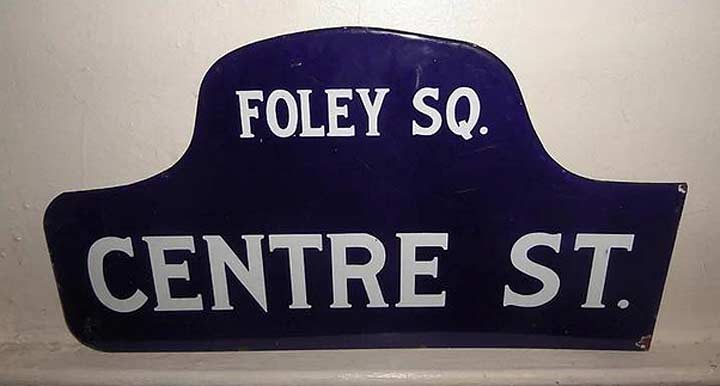
Foley Square, synonymous now with NYC’s criminal courts located there, took its name from Thomas F. Foley (1852-1925), late 19th Century Tammany leader, saloon owner and political mentor of Governor Al Smith. Centre Street was renamed from Collect Street (after the former Collect Pond) in 1838 because it led to Centre Market, one of NYC’s ‘official’ market spaces established in 1817. (There is still a Centre Market Place even though the market is long gone.) In the early 1800s, we were still using British spellings on street names.
About the “R” on this font. You almost never see two full lower serifs on both ‘legs’ of a capital R — that’s one of the elements that make this so-far unnamed font unique.
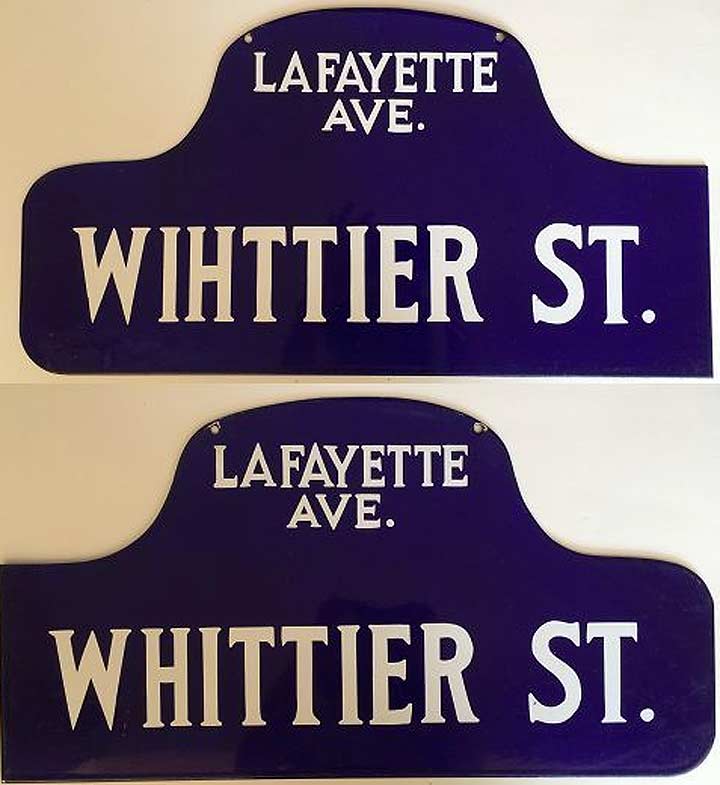
Typos are nothing new — and you see one here on this pair of signs that originally were placed on a corner in Hunt’s Point, Bronx. Streets are named for writers and poets in that part of town, in this case, John Greenleaf Whittier.
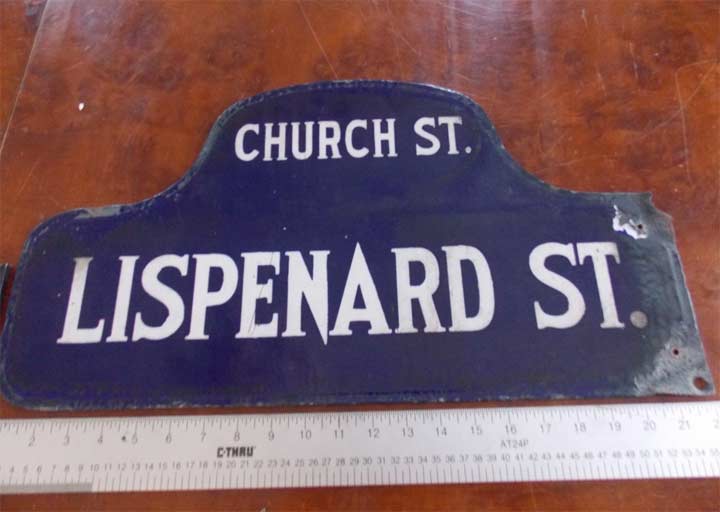
Lispenard Street is named for an early NYC landowner. I wrote an entire FNY page about it, since it’s a street name you’ll find nowhere else, or at least, not many places…
Like most of those only-in-New York street names, it was named for an original landowning family, or a person associated with Trinity Church. In this case, the street was named for either Anthony Lispenard (1640-1696) or grandson Leonard Lispenard (1714-1790). Anthony Lispenard was a refugee from 17th Century France, as many French Huguenots emigrated to the Colonies in the 1700s. He became an alderman, and assemblyman and a treasurer of King’s College (which developed into Columbia University). He married into the Rutgers family (the Lispenards also intermarried with the Bleeckers) and came to own much of the property that is now west of Broadway and south of Canal. Unfortunately, back then much of that was swampland, which became the source of troublesome mosquito infestations before the area was developed and built up with the aid of landfill.
Here, the signmakers had a little fun with the terminals on the A and N, making them jut above and below the other characters. This was probably done to just punch up the graphic look just a bit. Here’s an informative page on the parts of letters — in typography, there’s a name for every little bit of any individual character. Fascinating stuff if you’re into it.

An especially lengthy street name in which the signmakers had to really work hard to condense to fit 22 inches. Morningside Park, Avenue and Drive are named for an uptown hilly location with an especially good view of the sunrise in the east.
Note that if a numbered cross street is a “street” the word is eliminated in the ‘hump.’
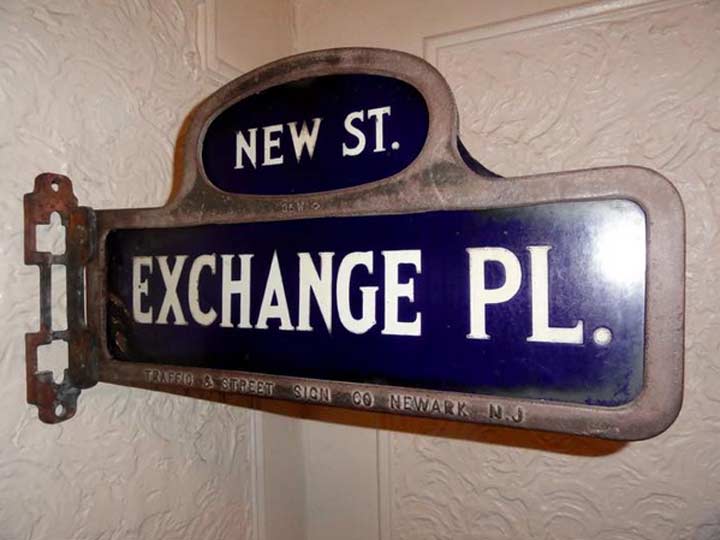
Here’s a find — a sign with a bracket attached, though I doubt it’s an original bracket. I don’t recall seeing the factory location listed on any other photo of a sign with an attached bracket.
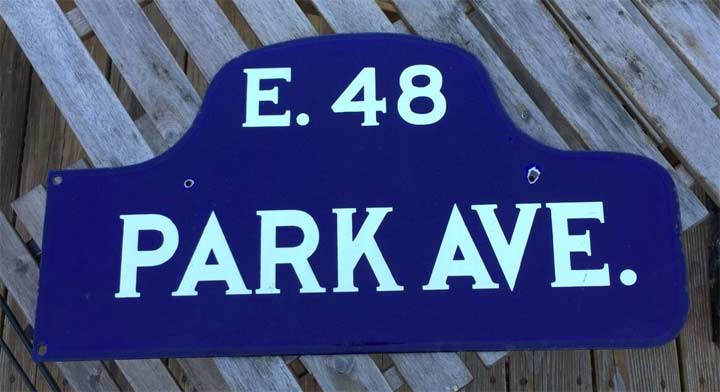
This corner likely looked a lot different than now when this sign was first installed. The corner is now amid a thicket of enormous glass and steel towers.
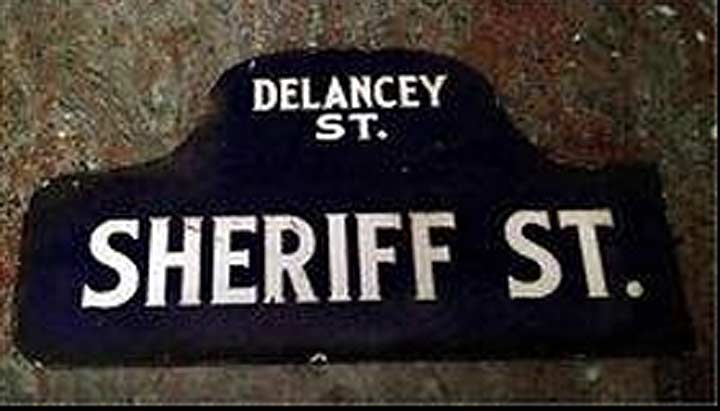
Though most of Sheriff Street was lost to urban renewal on the Lower East Side in the 1940s and 1950s, there remains a small piece of it at Delancey Street under the Williamsburg Bridge underpass. In addition, the ghost of Sheriff Street can be ascertained by the presence of a rusted Bishop Crook post on Broome Street.
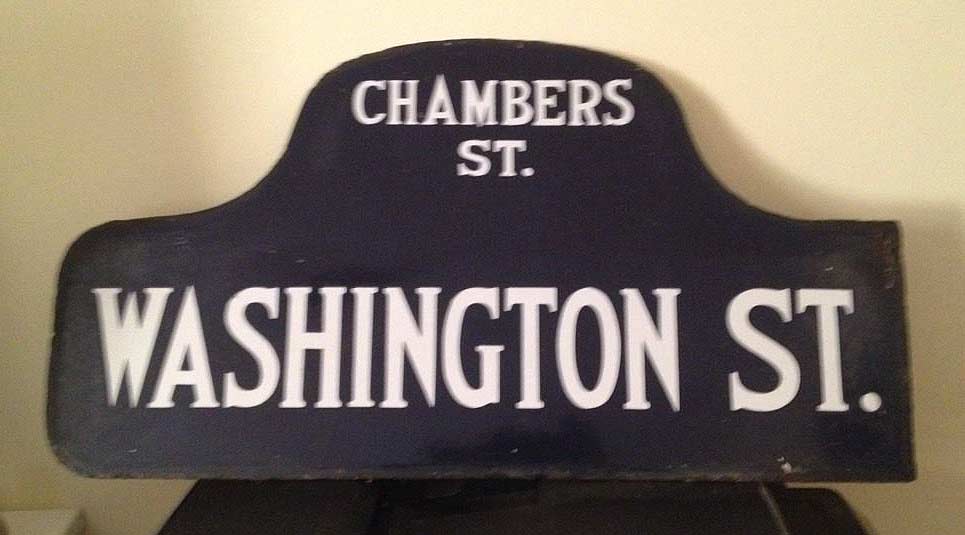
The intersection of Chambers and Washington Street in Tribeca was lost beginning around 1970 when streets were closed and excavations for the first World Trade Center begun. Inexplicably, though, a modern sign marking the lost intersection was in place for years until it was removed about a decade ago.
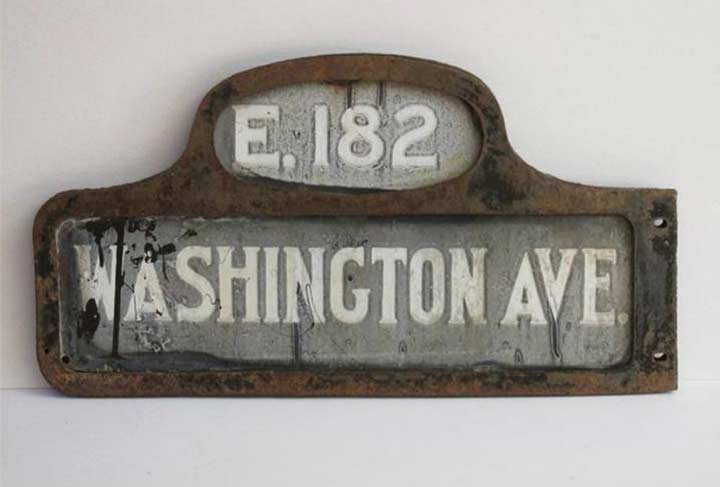
There’s no shortage of NYC streets named for the Father of His Country. This one was located in Fordham in the Bronx.

I have one of these relics for my very own. In 1988 I was working in a type shop on West 29th Street owned by three Russian immigrants. I would typeset and proofread the work that was in Roman characters, which could be any language from English to Rhaeto-Romansch (popularly known as “Swiss.”) There was a flea market-type lot at 6th Avenue and 28th where I picked this up for a cool $50. On EBay they go for $300 and up, but I won’t part with this unless prices soar to the $2000 range; I’ve seen some bids up to $1000 for them. That lot remained unbuilt-upon until just this past year when a high-rise went up there.
2/7/16

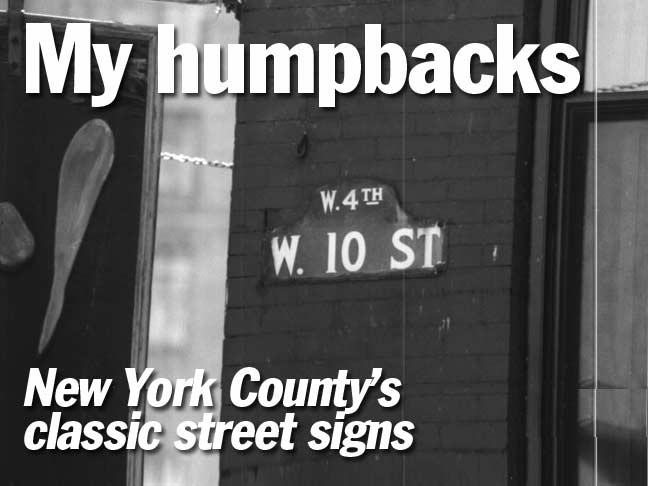
15 comments
Very interesting article. Since you brought up the serifs on the R, if you look closely at the variety of signs shown, the front leg of the R sometimes has a one-sided serif. The R on the Asser Levy Pl sign is completely different from all the other Rs. The Florence Pl sign reminds me of some of the hand lettered signs in the subway.
There imitation humpback signs posted on Park Avenue in the East Sixties.
There’s a navy “2nd Avenue” street sign in Astoria, on the north east corner of the intersection of Broadway and 31st street. It’s on an old corniced bldg so I’ve always wondered if it’s a turn of the century original, somehow sheltered from the wind + rain by the overhead tracks. Anyone got any thoughts?
https://www.google.com/maps/place/31st+St,+Queens,+NY/@40.7620865,-73.9253018,3a,22.3y,131.35h,98.88t/data=!3m7!1e1!3m5!1s6wg59lyF_4crCP-M2OskaQ!2e0!6s%2F%2Fgeo1.ggpht.com%2Fcbk%3Fpanoid%3D6wg59lyF_4crCP-M2OskaQ%26output%3Dthumbnail%26cb_client%3Dmaps_sv.tactile.gps%26thumb%3D2%26w%3D203%26h%3D100%26yaw%3D134.94073%26pitch%3D0!7i13312!8i6656!4m2!3m1!1s0x89c25f475acb4495:0x3b097d91f1ce22ee
I’ll have to take a closer shot of that one.
31st street was 2nd avenue under a former street naming system. My older relatives talked about “going down the avenue” when they were headed to 31st street.
I’ve got the coolest siugn-humpback from one of the rarest streets in N.Y.C.- the half street from a farm from the 1860’s that was in back of the legendary CBJB’s that fronted the bowery street. The back alley street known as ‘Extra Place’ . This is also the street where the early rock people hung iout from CBGB’s ansd the Ramones album ciover wsas taken for the ‘Rocket to New york’ album.
would love to see a photo
I believe the John Street sign is a forgery. There are several now on ebay. They tend to have the holes in the wrong place and have an overall paler color. Not to be confused with the humpback imitations noted by another poster.
I picked up a 100% wooden one from our local swap meet.
Central Park and W. 79st. Which is the entrance of the American Museum of Natural History.
Any clue how old is it and why is made out of wood?
Pics below at the link.
https://www.facebook.com/100003158862135/posts/1779758452139433/
it is probably a movie prop
Question, I have a humpback street sign without holes, just wondering why some Humpback signs have and some don’t?
I also noticed this, seems like some of the older ones from downtown don’t have holes. All of the other ones I have from the rest of manhattan and bronx have holes,
I have found at my house a corner post, double sided humpback, cast iron, street sign holder. It says municipal street sign company New York City. I have not seen another like it anywhere on the web and was hoping someone could help me identify it.
Is it possible to post a photo?
Were would one that has Amsterdam Ave on the top and bottom be located? I’ve looked on a map and can’t find it. Thanks